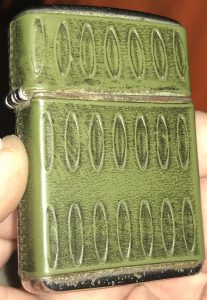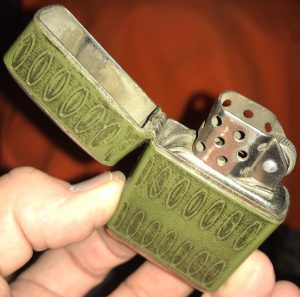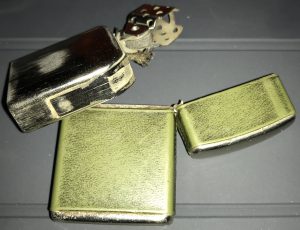With just a little attention, many of these old relics would be as useful as ever.
The Wheat from the Chaff
I recently purchased several large lots of old cigarette lighters. There are always certain attributes of a lot that pique my interest. If the lighters were purchased online then ordinarily I don’t really know much about them until I get them in my hands but once I do, there are a myriad of vintage lighter repair projects that could be necessary.
For instance, I may purchase a lot containing 40 lighters that I have to judge off

one photo. Still, there are things that catch your eye:
- Leather wrapped
- Nice, shiny looking Zippo in an old box
- Sterling or gold markings
- 3 barrel hinge
Champ Austria Leather Wrapped
So, I had seen this lighter in the photo and thought it looked pretty cool but it wasn’t until I received the package in the mail that I knew exactly what I was dealing with.
From that photo, same view as the one above, my guess would have been a flip top wick lighter but it could just as easily have been butane.
My heart sank though when I picked it up and the lid just fell freely open. Flip top lighters generally employ some form of tension to enable them to flip open and hold shut.
Some times that is achieved with a spring or cam and other times a method is used which is more resistance than tension. Anyway, there are numerous variations and combinations but this Champ lighter had the more crude resistance type tension.
I was glad to see that because it is the simplest of these systems to fix.
But I didn’t want to go and ruin the value of a lighter that a collector would pay a lot of money for. So, I did a quick EBay search and determined that there apparently isn’t much premium put on these old Champ lighters($5-$20) which makes it a perfect lighter for me to fool around with and put in my pocket for a while.
The Resistance “Spring”
With this type system, there is usually a straight, sometimes heat treated piece of metal attached in some fashion to the back of the insert. Now that I think of it, that straight piece of metal is a form of a spring.
Problem with this lighter was that piece of metal was broken off. I needed some kind of metal that was rigid enough to provide the tension but pliable enough that it could be cut, filed and shaped without anything other than snips and a hand file.
I settled on using a relatively thick blade from an old feeler gauge. Used a small pair of pliers to curl the sides of the blade and then the snips and file to round off the corners and the burrs caused by cutting. Then I just slowly, checking the spacing pretty often, worked it with some medium sandpaper until it fit just right.
sides of the blade and then the snips and file to round off the corners and the burrs caused by cutting. Then I just slowly, checking the spacing pretty often, worked it with some medium sandpaper until it fit just right.
I left the top squared off for now to make sure it was visible in the photo but when I cut it down I just have to make sure not to cut it too short. It’s a lot easier to snip a little bit more off than it is to shape a whole other blade.
Other Features of the Champ Austria Lighter
On the surface, it looks like so many of the other “Windproof” lighters made in the past century. But despite having to fix the tension problem, I think this may be a lighter I hold onto for a while.
It has a really cool faux leather wrapped grip that seems to be more sturdy than similar others I’ve seen.
The chimney cage design is particularly clever. It swivels on the same rivet that holds the flint wheel.  That allows access to the
That allows access to the
wick that is impossible with most other systems. It also appears more than strong enough to use as a handle to gain leverage when removing the insert from the case.
The underside of the insert has a cool little lightweight metal cover panel that is held in place by the flint screw. It is recessed and there’s a slot in the middle which makes refueling pretty easy if you’re careful.
And thanks to the spring that I fashioned, it holds closed better than any lighter that I have ever owned.
Are You a Collector? Smoker? Camper? Preparing for a Zombie Apocalypse?
Whatever it is that causes you to need fire, doesn’t really matter. I need it to light my medicine at any time of the day or night. Occasionally, I need it to light a lantern. Every now and then, I use it to light a water heater or furnace.
I intend to fill these posts with as much helpful and useful information as I can  about old cigarette lighters. I will also be posting about some of the ways we employ fire and perhaps some alternatives or rediscovered uses, gadgets, etc.
about old cigarette lighters. I will also be posting about some of the ways we employ fire and perhaps some alternatives or rediscovered uses, gadgets, etc.
If you collect vintage cigarette lighters, I would love to hear your comments. My main purpose is putting quality old lighters back into service. I have discussed that in another post. But there is a part of me that understands the desire to collect things, I just like to collect things that not only work but I am able to put to use.
I would love to hear from anyone who is interested in performing similar repairs or having similar repairs done for you. Maybe you have an heirloom lighter that you don’t want to take the chance of losing in the mail. Comment below, email, text or call. I would love to help you. I spent 25 yrs working for the U.S. Postal Service.
Now, this is what I do. Buy, sell, sometimes fix, fool around with old cigarette lighters. I am up late every night(that’s when the magic happens) so hit me up. I’ll get back to you as quickly as I can.
And please remember that we are IN SEARCH OF old lighters of all kinds: new old stock, lots, need service, whatever. We accept consignments on arrangement.
Joseph
bossman@dependableflame.com
(405)693-5678
Hin there, I used to collect old lighters my self. I had some quite unique ones but over time they got legs or broke. I will look at my old stuff and when I find some I contact you.
Nice work, I like that. Stefan
Thank you, Stefan. I think these old lighters are way more interesting than a hunk of plastic we can pick up at the gas station. If you find some old ones, let me know and we’ll see what we can do about getting them back up and running. This Champ lighter may not be unique but has a lot of character and I expect it will serve me well.
I am interested in your skill.
I have never heard about it.
Thank you for sharing your experience.
Anytime, Eli. Thank you for visiting and let me know if you need help fixing an old lighter.
Interesting article, and looking forward to your future posts!
Thank you, Clark. Be sure to let me know if there’s a particular lighter you’d like to read more about. And remember, 10% of all our Ebay sales goes to HDSA-HUNTINGTON’S DISEASE SOCIETY OF AMERICA
Hello. I have a WWl era brass trench lighter made from bullet casings that’s heavily tarnished. While I replaced the flint, wick and cotton and the lighter is working condition I’m interested in having it restored to its formal beauty. Any suggestions?
Thank you for the question Carl and while I do appreciate the desire to increase the aesthetic appeal of your old lighter, I find myself increasingly restricted by the limits time itself has placed on me as it conspired with the elements to effect their toll. I really just wipe them off, not wanting to remove any patina and possibly value or proof of age.✌️
Hi Joseph, Thanks for sharing the lighters and your expertise on repairing the lighters with us. I am social smoker and occasionally use lighter. I haven’t seen the lighters you showed here for a long time. They looks nice. I am going to ebay to search for lighter like yours. Good luck with your endeavor!
Thank you, Anthony. Visit My eBay Store: DependableFlame If you need any advice sorting through what you find, just let me know. If everyone would stop using disposable we could really make a difference. We would be carrying cooler and better lighters too.
Your post is very interesting. I think we may have a few old lighters around the house. I will pass this on.
Thank you, Paula. You might be surprised by the usefulness of some of the old items that we all having cluttering up our drawers and closets. Don’t hesitate to ask if there’s anything I can do to help you.
Hello Joseph, Thank you for educating me about lighters. How interesting this article was. I wonder during the 1920’s when elaborate lighters where such a rage, what are they worth now? I would not have thought also there was a market for fixing a lighter. Vintage lighters, how interesting. I certainly learned a lot today. Great job! ariel
Thanks for the kind words, Ariel. Many of the lighters from that period have tremendous value. The thing I always struggle with is my desire to use them. Repairing some of these lighters is a really cool way to get to carry lighters that I would otherwise be unable to afford. I don’t like throwing away money though, so I sell a good many old ones because of their value as collectibles. I think the oldest that I have actually handled are some of those glass and silver table lighters from the ’30s.
Hi I have a problem with a great lighter I have. It’s an original Colibri of London Lasatron it’s sparking but I’m not getting a flameguess it’s blocked what’s the best way to unblock the jet it’s taking gas but not letting any out
Thank you, Rob, for your question. Unfortunately, I don’t do much with butane lighters. You might try hitting it with some compressed air. Other help may be found here.
Your information has helped me replace the flint and adjust the wick and flame on my Father’s 1953-56 Dunhill Rollalite lighter. He stopped smoking before my memory can recall, so the lighter has not been used for 60 years. It is working nicely now and I will enjoy looking for an excuse to use it. Thanks!
Thank you very much for the comment, I’m glad the site has been helpful in getting your lighter up and running again. Dunhills are some of my favorite lighters. You can also find links to purchase vintage lighter supplies like flint and wicks here.